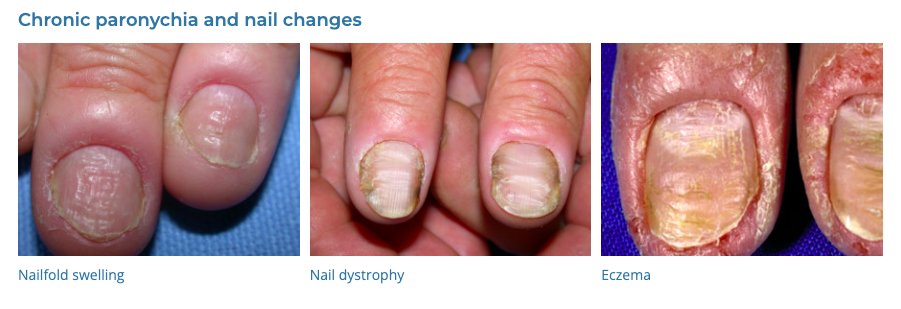Infected fingers or toes, commonly referred to as paronychia, are a frequent occurrence and can range from mild infections to severe ones that require urgent medical attention.
Causes
- Bacterial Infection: Often caused by Staphylococcus or Streptococcus bacteria. Commonly enters through small cuts or breaks in the skin around the nail.
- Fungal Infection: Yeasts like Candida can cause chronic paronychia, typically slower to develop.
- Viral Infection: Herpes viruses can cause Herpetic whitlow
- Ingrown Toenails: Can lead to infection at the nail fold.
- Injury: Cuts, nail biting, manicures, or pedicures can introduce bacteria or fungi into the skin.
- Contact with Irritants or Allergens: Chemicals or prolonged exposure to water can lead to skin irritation and infection.
- Underlying Skin Conditions: Such as eczema or psoriasis.
Diagnosis
- Clinical Examination: Redness, swelling, tenderness, pus, and warmth around the nail are indicative of infection.
- Medical History: Inquiring about recent injuries, exposure to water or chemicals, and personal hygiene practices.
- Culture: If the infection is severe or recurrent, a sample of the pus may be cultured to identify the causative organism.
- Blood Tests: Rarely needed unless there is concern for a more systemic infection.
Differential Diagnosis
- Herpetic Whitlow: A herpes virus infection that can mimic bacterial or fungal paronychia.
- Felon: A deeper infection of the fingertip’s pad.
- Gout or Pseudogout: These conditions can sometimes present with redness and swelling in the joints of fingers or toes.
- Osteomyelitis: An infection of the bone.
- Insect Bites or Stings: Can cause localized redness, swelling, and pain.
- Management
Conservative Treatment:
- Avoidance: Keeping the area dry, avoiding nail biting, and avoiding irritants.
- Medications:
- Over-the-Counter Pain Relievers: Such as acetaminophen or ibuprofen.
- Topical Antibiotics: Mupirocin or Neomycin if the infection is mild.
- Oral Antibiotics: For more severe or spreading infections. The choice of antibiotic depends on the suspected or confirmed organism.
- Flucloxacillin
- Cephalexin
- Clindamycin
- Bactrim
- Antifungal Medications: In cases of fungal infection.
- Terbinifine 250mg oral daily until clear is first line
- Surgical Treatment:
- Incision and Drainage: If there is an abscess (a collection of pus).
- Follow-Up and Monitoring: To ensure resolution of the infection and to prevent recurrence.
Conclusion
The key to effectively managing infected fingers or toes lies in early diagnosis and appropriate treatment. Most infections respond well to conservative treatment, but more severe cases might require antibiotics or even surgical intervention. Preventive measures include proper nail care, avoiding nail biting, and protecting the hands and feet from excessive moisture and injury. If there is no improvement with initial treatment, or if symptoms worsen, further medical evaluation is warranted.



